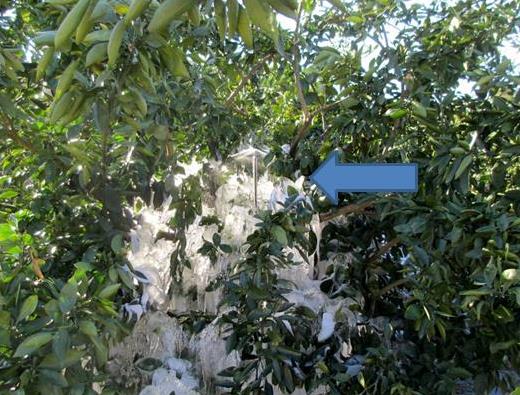Northwest Florida, in the next few days, is set to receive some of the coldest weather in recent years, with lows ranging from 18 ºF to 28 ºF three to four nights in a row. This has the potential to impact our home garden citrus and winter vegetables such as radish, cabbage, kale and parsley. The good news is that properly protected trees will receive minimal damage to major limbs and graft union.

One methof of protection is known as Microsprinkler-irrigation, the option of choice used by Panhandle Citrus producers for cold protection, has proven to be effective through several tests in central Florida. This practice can protect entire satsuma trees if the trees are short in stature. Keep in mind that the sprinklers must be running throughout the entire freeze event. They need to be turned on at 36º F and left on until the temperature reaches 42 ºF. If the tree is too large for complete coverage, the emitter should be located on the windy side of the tree, roughly 1-2 feet away from the trunk, to be sure that the water covers the graft union. Most trees will eventually recover from freezing temperatures if the union is not damaged. Microsprinkler-irrigation, will not protect fruit, therefore, all fruit must be harvested before temperatures reach below 25 ºF
A major factor to consider when planting citrus in the Florida Panhandle includes using only cold-adapted citrus cultivars. Satsumas, or satsuma mandarins, are the most widely planted cold hardy citrus types in North Florida. Three cultivars that have been planted for many years throughout northwest Florida are Owari, Silverhill and Kimbrough, with Owari being the most popular. For cold-hardy citrus plantings to be successful, the cultivars must be grafted to a cold tolerant rootstock. Trifoliate-orange (Poncirus trifoliata) has been the rootstock of choice for imparting cold-hardiness, but sour orange (Citrus × aurantium) has been used as well for cold hardiness qualities.
Winter vegetable plots should be covered with blankets, sheets or frost cloth during temperatures below 30 °F. Remember to remove cold protection once the freeze event has passed, with the exception of frost cloth, which can be left on longer.
Additional tips for citrus protection during extreme freeze events:
- Generally, satsuma are cold tolerant down to 15° F, but young trees, or trees yet to achieve dormancy, are usually only tolerant to 26°F. Fruit should not sustain damage from temperatures above 25°F. In fact, temperatures between 25°F and 35°F enhance the sweetness of the fruit.
- Physical windbreaks will reduce the harmful effects of cold winds if placed north and east of the tree.
- Water is a great asset, because well-watered soil retains more heat, and a well-watered plant has less chance of drying out during an advective freeze (freeze caused by cold air mass, with wind).
- Extreme winds sometimes make the effects of freeze events worse if the trees are not well watered. A hydrated tree is a well-protected tree. On the whole, still, or windless nights (radiational freezes) make for worse freeze events since cold air will “settle” into low areas.
- Wrap the trunk with commercial tree wrap or mound soil around the base of the tree up to 2 feet. This will protect the graft of the young tree. Thus, if the branches freeze the graft union will be protected.
- For established citrus trees, mound soil around the tree in a cone formation. Do not mulch the trees over the winter since heat that radiates up from the soil will be blocked somewhat by mulch.
- Do not cover trees with plastic tarp, these will not protect the tree and can “cook” the tree once the sun comes out.
- For additional information check out this publication on micro-sprinkler irrigation.
If you have further questions, contact your extension office at the Solutions for your Life website.
Source: UF/IFAS Pest Alert
Note: All images and contents are the property of UF/IFAS.



